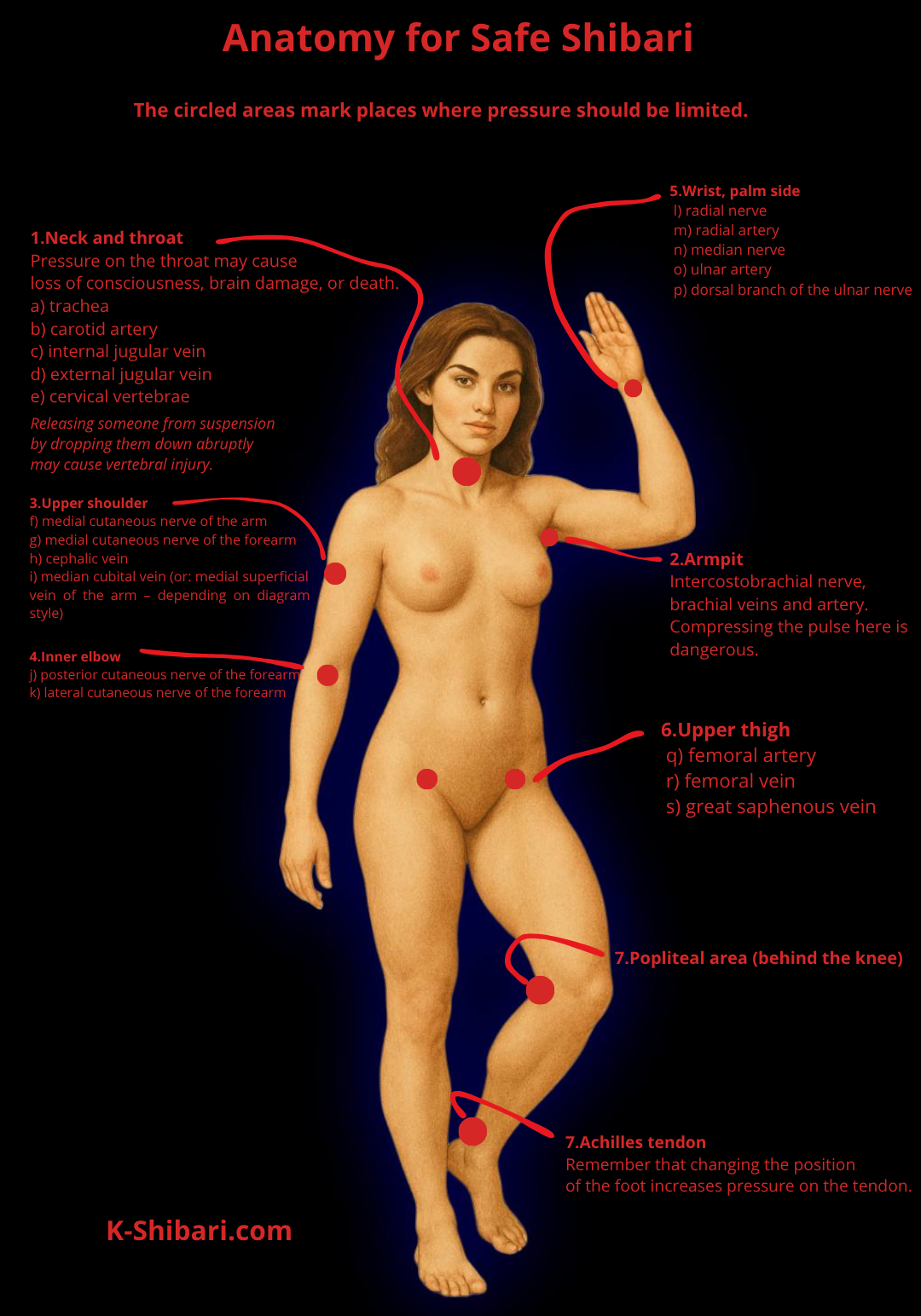(On this diagram you can see areas that are considered unsafe during shibari. Nawashi either avoid tying them entirely or use special knots designed specifically for these zones).
19 Shibari Safety Principles
These 19 rules will not only help you stay healthy, but will also give you an understanding of how to deal with situations that sometimes arise during shibari.
In addition, following the rules will increase the level of safety in the mjo and the implementation of the rules will increase trust between participants, which is conducive to deep states.
1. It is forbidden to tie up unrelaxed Mjo. When a person's body is tense, it indicates that the model will be tense during the session, and a tense body is more easily injured, so MJOs who cannot trust and surrender to the flow of relaxation are not allowed to participate in the sessions.
2. Self-tightening or slipping knots. Shibari is a tying based on technical principles that imply safe, proven patterns — they are studied in shibari schools, taught by masters, but YouTube bloggers often do not know them and create content for the sake of views and likes without taking safety into account.
What can happen: ropes can cause injuries under the weight of the body, and joints are weak points — there are highways of nerves and arteries: radial, medial, elbow, some of the most common injuries in case of violation of safety rules.
3. Ropes and necks — all military regulations have a rule "do not point an unloaded firearm at a person", as life can end due to an accident for one of the parties. Submission is one of the power games and what is enjoyable on the floor under your own weight can lead to irreversible consequences when suspended or hyper-excited; submission.
4. Rope on the joints — it is easy to damage articular cartilage, tissues, and nerves of the joints, so masters do not apply knots to: elbows, knees, shoulders (Fig. 1). Be careful with: hip joint, wrist, ankle.
5. Rope cutting tool — Every Navashi carries a cutting tool with the ropes, such as a special knife or scissors for emergency release of a bound person, in case the Mjo needs to be released quickly. For the novice Navashi, be confident in your tool and test it — cut a few ropes before tying them.
6. Watch the limbs — the hands and feet will be restricted from the usual flow of blood, as a result they will be cold and even turn purple, which means that venous blood is flowing to them, indicating the need to loosen the tension of the ropes that restrict blood flow.
7. Breasts and genitals — do not try to repeat what you see in porn (sometimes the authors are masters in film production, but amateurs in shibari and act with the lack of the necessary qualifications in shibari, they will not show the consequences of their actions) without knowledge of the anatomy of the breast and genitals.
8. The rope burns — pulling the rope over the body under pressure, you risk burning the skin, be careful, such a burn takes a long time to heal and is extremely unpleasant.
9. Convex moles (nevi) — avoid them, otherwise you will have to stop the binding process and deal with stopping the blood and treating the wound.
10. Find out the state of health of Mjo:
Lymph nodes — we do not bind the areas where lymph nodes are concentrated, and if they are inflamed, we understand the presence of an infection or disease in this area of the body.
Joint injuries — find out their condition, be careful if there have been previous injuries.
Blood pressure — with a mjo who has problems with blood pressure (low/high), heart problems, be especially careful, ask your instructor about the limits of what is allowed.
Mental health — only healthy people are allowed to practice, people with mental disorders, depression are not allowed to go to shibari (of course, this assessment can only be subjective).
11. Stop words — before the session, make sure that you both know the stop words that will stop the session, this will allow the mjo to feel safer and therefore go deeper.
Warn the model that she can use the word "yellow" to indicate boundaries — this word means that she should not go any further. "Red" — after saying this stop word, the session ends and Navashi unties Mjo.
12. Keep track of time — as described above, the practice entails restricting blood flow. It is recommended to keep one harness without re-binding for no more than 30 minutes. The dynamic process of binding/unbinding by masters during a session takes about 40-60 minutes.
13. Do not leave a connected person unattended — in order to keep the degree of the session high, keep your mjo in sight, leaving her alone risks creating conditions conducive to the state of "abandonment", thereby reducing the level of trust, and trust is the most important criterion for achieving deep states.
14. Position your mjo in stable postures — when you bind standing up, there is a risk of getting carried away with the knots and not keeping track of the mjo's balance. This is especially true when binding the legs in a standing position.
15. If you think that everything is fine, but your mjo is not, then she is right, not you — the trap of "I know better" is most often fallen into by beginners who have already learnt something and mistakenly think that they know something.
Of the two of you, it is the mjo who feels what she feels, you can only assume, and you cannot understand this moan of pleasure or pain for sure, so here in 100 percent of cases, listen to what she is telling you. In cases of light ligaments, if you are in doubt about the reaction of an unfamiliar mujo, clarify, tie up those ties that have caused discomfort — tying up is a pleasant process.
16. Alcohol or drug intoxication — during the session, oxytocin, dopamine, endorphins are released, some of these hormones are natural painkillers, mixing with alcohol can lead to loss of control and, as a result, confidence in you and the practice. What's more, you run the risk of injury. Practice only when you are sober.
17. Have a first aid kit at hand — the practice is traumatic, in case of injury, God forbid, you will reduce unnecessary fuss when eliminating the blood flow or providing first aid, one of the necessary means is a haemostatic haemostatic agent (or analogues), it increases blood clotting, and within a few minutes the wound stops bleeding.
18. Never try to hang people unless you have been trained to do so — the Navas have the knowledge to do this, and those who have not been trained can easily drop a mjo. If a person who is immobile falls to the floor and cannot regroup, they can be seriously injured.
19. A full stomach — when you have eaten, blood is concentrated in the stomach, and there is an outflow from other organs, which leads to a desire to rest and drowsiness — tie up an hour or two after eating.
One of the most common injuries of shibari practitioners is a pinched radial nerve in the wrist, shown in the picture
The structure of the nerve.
A nerve is made up of several motor and sensory nerve fibres (Fig. 1), consisting of axons (Fig. 2) protected by myelin (Fig. 3). In the case of prolonged or excessive compression, there is a risk of damage to this myelin (neurapraxia) with subsequent loss of motor and sensory function. The recovery process can take from a few minutes to 12 weeks.
During the first lesson, we look at how to bind your wrists as safely as possible.
Explore More on Safe and Conscious Shibari:
– Psychological Principles of Safety
How to negotiate boundaries, read your model’s signals, and stay connected.
– 7 Pleasant States During a Shibari Session
What models experience physically and emotionally – and how to make it deeply fulfilling.
– 5 Steps to Start Shibari
A practical guide for those taking their first confident steps into rope.
– Rope Care Instructions
True safety begins with clean, strong, and responsive ropes.
– Kinky Glossary
Understand the terms, the culture, and your partner – with clarity.


